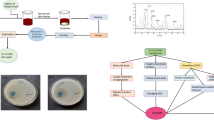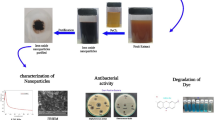Abstract—
The paper reports original data on concentration levels of a broad spectrum of major (Ca, Na, Mg, and K), minor and trace elements, including heavy metals (Fe, Cu, Zn, Mn, Se, Mo, Co, Ni, As, Br, Pb, Cd, Sn, Ga, Ge, Te, Ta, Al, Rb, Ba, Sr, Cs, Zr, In, Sb, Hf, W, Re, Tl, Th, and U) and REE (Sc, Y, La, Ce, Pr, Nd, Sm, Eu, Gd, Tb, Dy, Ho, Er, Tm, Yb, and Lu) in the solid phase of shungite and general tendencies in the transfer of these elements into water extractant of fullerene (C60). A modified technique for obtaining water shungite extract (WSE) is adapted to be used in biotechnologies. REE can be efficiently chelated from the extract using the EDTA complexonate with the subsequent visualization of the interaction effect using conventional crystalloscopic techniques. Shungite was determined to suppress pathogenic microbial flora. The impact of WSE on nanobacteria, the virions of foot-and-mouth disease virus, and other nanostructures is likely explained by that the shungite contains REE, whose cations chemically bind with negatively charged phosphate residues in the cell membranes and nucleic acids to form conglomerates. Data acquired on shungite from the Zagozhinskoe field make it possible to develop biotechnologies for serum purification of various bacteria, viruses, and nanobacteria.










Similar content being viewed by others
REFERENCES
Animal Cell in Culture, Ed. by L. P. D’yakonov (Sputnik+, Moscow, 2009) [iN Russian].
T. Baati, F. Bourasset, N. Gharbi, et al., “The prolongation of the lifespan of rats by repeated oral administration of fullerene,” Biomater. 33 (8), 4936–4946 (2012).
P. R. Buseck, S. J. Tsipursky, and R. Hettich, “Fullerenes from the geological environment,” Science 257 (5), 215–217 (1992).
V. I. Grosheva, Extended Abstract of Candidate’s Dissertation in Physics and Mathematics (Moscow, 2006).
S. M. Gulyaev, Extended Abstract of Candidate’s Dissertation in Physics and Mathematics (Ulan-Ude, 2004).
M. I. Iskandarov, “Biological properties of rare-earth-based specimens,” Veterinar. Kormlenie, No. 3, 13–15 (2016).
S. S. Iskandarova, M. I. Gulyukin, et al., Development of Rare-Earth Metal-Based Pharmaceutical Specimen for the Protection of Skin from Impact of Pathogenic Microflora And Unfavorable Environmental Factors. Method Book (SibAK, Novosibirsk, 2019) [in Russian].
V. K. Ivanov, A. B. Shcherbakov, and A. V. Usatenko, “Structural-sensitive properties and biomedical application of nanodispersed cerium dioxide,” Us. Khimii 78 (9), 924–941 (2009).
Yu. K. Kalinin and V. V. Kovalevsky, “Shungite rocks: horizons of scientific search,” Nauka v Rossii, No. 6, 66–72 (2013).
N. F. Kamakin, A. K. Matusevich, and A. N. Koshkin, “Prospects of the development of crystallographic methods,” Vyatsk. Medits. Vestn., No. 3, 6–11 (2003).
V. A. Krotous, Therapeutic Properties of Shungite, 6th Edition (Petrozavodsk, 2016) [in Russian]. A. V. Lapo, Traces of the Past Biospheres (Znanie, Moscow, 1987) [in Russian].
A. Pol, T. Barends, A. Dietl, et al., “Rare earth metals are essential for methanotrophic life in volcanic mudpots,” Environ. Microbial. 16 (1), 255–264 (2014).
A. P. Ponomarev, E. V. Belik, B. L. Manin, and M. M. Kogan, A Method of Purification of Blood Serum of Cattle from Contaminating Agents, RF Patent No. 2664729 (RU 2664729, MПK G01N 33/49), Byul. No. 24 (2018).
A. P. Ponomarev, Electron Microscopy of Nanobacteria and Other Representatives of Micro- and Nano-World (IP Zhuravlev, Vladimir, 2011) [in Russian].
A. M. Tremisova, F. G. Akhmetova, and V. P. Korostyleva, Influence of shungites on the immune status of calves,” Probl. Veterinar. Sanitarii, Gigieny, Ekol., No. 3, 72–74 (2011).
V. I. Vernadskii, Living Matter and Biosphere, Ed. by A. L. Yanshin (Nauka, Moscowl 1994) [in Russian].
Author information
Authors and Affiliations
Corresponding authors
Ethics declarations
The authors declare that they have no conflicts of interest.
Additional information
Translated by E. Kurdyukov
Rights and permissions
About this article
Cite this article
Ponomaryov, A.P., Tyutikov, S.F., Podkolzin, I.V. et al. Assessment of the Chemical Composition of Shungite of the Zazhoginsky Field for Its Use in Biotechnology. Geochem. Int. 60, 203–212 (2022). https://doi.org/10.1134/S0016702922020070
Received:
Revised:
Accepted:
Published:
Issue Date:
DOI: https://doi.org/10.1134/S0016702922020070




